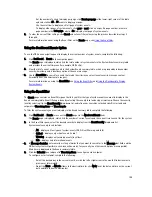
The 1-GbE, 10-GbE, and 10-GbE SFP+ NICs configurations bond multiple Ethernet ports into a single interface by default:
•
For the 1-GbE ports, this means that the four ports in the DR4000 system (or the six ports in the DR4100 system)
are bonded together to form one interface connection.
•
For the 10-GbE and 10-GbE SFP+ ports, this means that to operate at maximum speed, only the two high-speed
Ethernet ports are bonded together to form one interface connection.
The DR Series system supports configuring the NICs to use either of the two following supported bonding
configurations:
•
ALB—adaptive load balancing (ALB) is the default; this configuration does not require special switch support,
but it does require the data source machine to be on the same subnet as the DR Series system. The ALB is
mediated by the Address Resolution Protocol (ARP).
•
802.3ad—also known as Link Aggregation Control Protocol (LACP) is used for copper-wired Ethernet
applications; this configuration does require special switch management (the requirement being that it be
managed from the switch).
For more information, see
Configuring Networking Settings
.
ALB and the 802.3ad are link aggregation methods that aggregate or combine multiple network connections in parallel to
increase throughput beyond what a single connection could support.
Link aggregation for Ethernet connections also provides redundancy, in case one of the links fails. The DR Series system
also comes with a Serial-Attached SCSI (SAS) card for future enhancements.
The DR Series system ships equipped with the 1-GbE, I-GbE, or 10-GbE SFP+ NIC. To visually differentiate between the
NIC types, observe the markings on the NICs installed in the rear chassis of the DR Series system:
•
1-GbE NIC is labeled as GRN=10 ORN=100 YEL=1000
•
10-GbE NIC is labeled as 10G=GRN 1G=YLW
NOTE: There are three key requirements to meet if you choose to use the 10-GbE NIC configuration: 1) use only
CAT6a copper cabling, 2) you must have two switch ports capable of supporting 10-GbE NICs, and 3) you do not
connect the 1-GbE ports.
NOTE: There are three key requirements to meet if you choose to use the 10-GbE SFP+ NIC configuration: 1) use
only Dell-supported SFP+ transceivers, 2) you must have two switch ports capable of supporting 10-GbE SFP+ NICs
(and LC fiber-optic or twin-axial cabling), and 3) you do not connect the 1-GbE ports.
To verify the types of NICs that are installed in your system, click System Configuration
→
Networking to display the NIC
information. For more information, see
Configuring Networking Settings
. In addition, you can also use the DR Series
system CLI network --show command to display other NIC-related information.
Monitoring System Usage
To display the current DR Series system usage, click Dashboard
→
Usage to display the Usage page. This page allows
you to monitor system status and the currently displayed system usage status is based on the Latest Range or Time
Range settings that are in effect. These settings define the output for the following tab categories on the Usage page:
•
CPU Load
•
System
•
Memory
•
Active Processes
•
Protocols
•
Network
•
Disk
108
Содержание PowerVault DX6112
Страница 1: ...Dell DR Series System Administrator Guide ...
Страница 32: ...32 ...
Страница 70: ...70 ...
Страница 86: ...86 ...
Страница 100: ...For more information on Replication schedules see Creating a Replication Schedule 100 ...
Страница 114: ...114 ...
















































